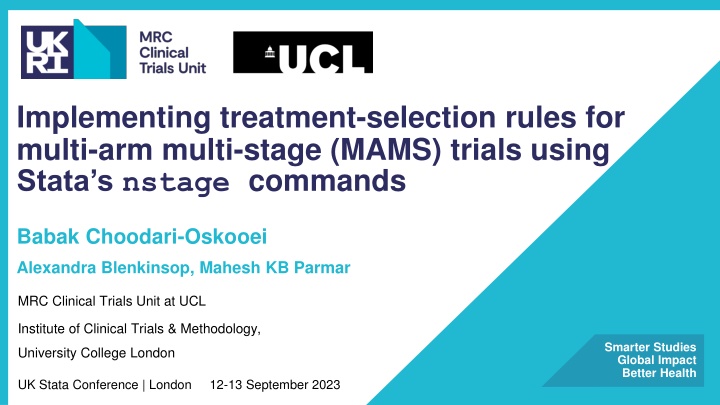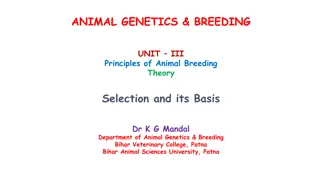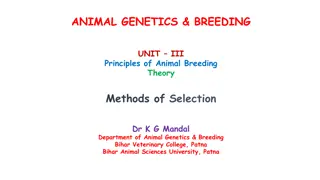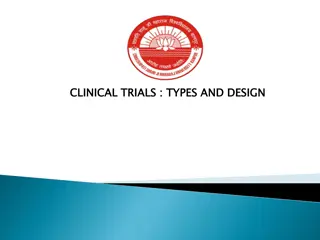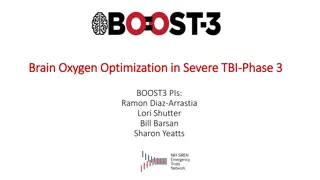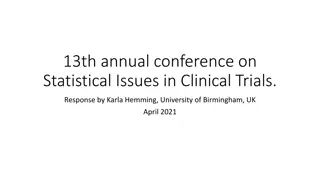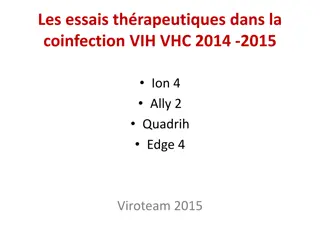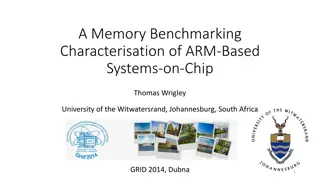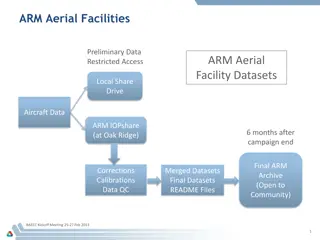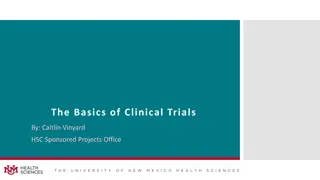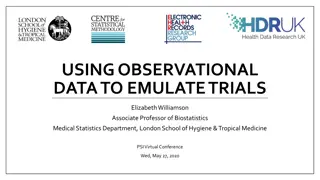Implementing Treatment Selection Rules for Multi-Arm Multi-Stage Trials Using Stata's nstage Commands
Implementing treatment selection rules for multi-arm multi-stage (MAMS) trials involves understanding the methods and designs, as demonstrated through the ROSSINI-2 trial example in surgery. The focus is on control of operating characteristics, sample size calculations, and updates to Stata's nstagebin command for effective trial implementation.
Uploaded on Apr 19, 2025 | 3 Views
Download Presentation

Please find below an Image/Link to download the presentation.
The content on the website is provided AS IS for your information and personal use only. It may not be sold, licensed, or shared on other websites without obtaining consent from the author.If you encounter any issues during the download, it is possible that the publisher has removed the file from their server.
You are allowed to download the files provided on this website for personal or commercial use, subject to the condition that they are used lawfully. All files are the property of their respective owners.
The content on the website is provided AS IS for your information and personal use only. It may not be sold, licensed, or shared on other websites without obtaining consent from the author.
E N D
Presentation Transcript
Implementing treatment-selection rules for multi-arm multi-stage (MAMS) trials using Stata s nstage commands Babak Choodari-Oskooei Alexandra Blenkinsop, Mahesh KB Parmar MRC Clinical Trials Unit at UCL Institute of Clinical Trials & Methodology, Smarter Studies Global Impact Better Health University College London UK Stata Conference | London 12-13 September 2023
Outline 1. Introduction to standard multi-arm multi-stage (MAMS) designs 2. MAMS selection designs 3. ROSSINI-2 trial example: Surgery ( to prevent surgical wound infection) 4. Sample size and operating characteristics of MAMS selection designs 5. Update to nstagebin command 6. Summary 2
Multi-Arm Multi-Stage (MAMS) designs 1. Methods by Royston et al. (2003) For time-to-event outcomes E4 E5 Control E1 E2 E3 E6 E7 2. Context: Randomised clinical trials Efficacy and safety of new interventions in a defined population Stage 1 3. Control of operating characteristics are important Probability of false positive (Type I error) Of interest to regulators and reviewers Probability of true positive (Power) Of interest to funders Stage 2 4. Multiple research arms vs a common control arm Stage 3 5. MAMS design has many advantages and challenges 3
Example: ROSSINI-2 MAMS design 8-arm 3-stage trial in surgery i.e. 7 pairwise comparisons Clinical outcome composite binary, Surgical site infection (SSI) within 4 weeks Same outcome used in all stages Primary design parameters Value Overall type I error rate (FWER*) 0.025 (one-sided) Overall pairwise power 0.85 Control arm event rate 15% Target effect size (reduction) 5% (reduction from Ctrl. arm event rate) *) FWER is strongly controlled using Dunnett s probability/correction. 5
Example the surgical trial 8-arm 3-stage surgical trial Clinical outcome: composite binary, surgical site infection (SSI); Main interventions A) Chlorhexidine 2% alcoholic skin prep [versus any other standard wound prep agent of surgeon s choice] B) Loban-impregnated incise drapes [versus no drape] C] Gentamicin-impregnated collagen sponge [versus no sponge] 6
Two steps to design such study Step 1: Find stagewise design significance levels and power given prespecified overall operating characteristics: Control the overall type I rate (FWER) and power Consider available information about the effectiveness of treatments nstagebinopt Stata command Choodari-Oskooei et al. (2023), DOI:https://doi.org/10.1177/1536867X231196295 Step 2: Conduct sample size calculations and estimate the trial timelines, using the design parameters found in Step 1. nstagebin Stata command 7
nstagebinopt command for designs Syntax: nstagebinopt, alpha(0.025) power(0.85) fwer nstage(3) arms(8) theta0(0) theta1(-0.05) ctrlp(0.15) ltfu(0.04) fu(4) accrate(118 248 248) aratio(0.5) plot Aim to control of the FWER Remove if aim is to control pairwise error rate (PWER) 8
nstagebinopt output About ?: 1) It is pre-specified. 2) Based on available information about the effectiveness of the treatments. n-stage (binary) trial design version 1.0.2, 09 June 2023 --------------------------------------------------------------------------------- Admissible designs for a 8-arm 3-stage trial with binary outcome based on Choodari-Oskooei, Bratton, and Parmar (2023) Stata Journal 23(3). --------------------------------------------------------------------------------- Design q-range Stage Sig. Power Alloc. E(N|H0) E(N|H1) FWER number level ratio (SE) --------------------------------------------------------------------------------- 1 [0.00,0.09] 1 0.31 0.93 0.50 4658 8667 0.0249 2 0.16 0.93 (0.0003) 3 0.005 0.92 --------------------------------------------------------------------------------- 2 [0.10,0.65] 1 0.40 0.94 0.50 4683 8437 0.0253 2 0.14 0.94 (0.0003) 3 0.005 0.91 --------------------------------------------------------------------------------- 3 [0.66,0.77] 1 0.15 0.93 0.50 4989 8277 0.0254 2 0.08 0.93 (0.0003) 3 0.005 0.90 --------------------------------------------------------------------------------- 4 [0.78,1.00] 1 0.27 0.99 0.50 6506 7824 0.0253 2 0.14 0.99 (0.0003) 3 0.004 0.85 --------------------------------------------------------------------------------- Note: each design minimises the loss function (1-q)E(N|H0)+qE(N|H1) for values of q specified in q_range. H1 is the hypothesis that all of the experimental arms are effective. Optimal (admissible) for wider range of ? Loss function used in nstagebinopt
8-arm 3-stage optimal standard MAMS design Sig. level (One-sided) Design power Overall Sample size Duration (months) Stage Analysis 1 0.40 Lack-of-benefit 0.94 2358 20 2 0.14 Lack-of-benefit 0.94 4995 31 3 0.005 Efficacy 0.91 8847 50 Sample size for funding application. Overall *) Familywise type I error rate (FWER), calculated using Dunnett s probability **) Overall pairwise power as defined by Royston et al. (2003) 0.025* 0.85** Note: Sample size: if we run the same trial as separate 7 two-arm trials: 11,396 (7*1628) The FWER across 7 two-arm trials is 0.16, 1-(1-0.025)^7 ***) nstagebin, alpha(0.40 0.14 0.005) power(0.94 0.94 0.91) nstage(3) theta0(0) theta1(-0.05) ctrlp(0.15) arms(8 8 8) ltfu(0.04) fu(4) accrate(118 248 248) aratio(0.5) tunit(4) ess 10
8-arm 3-stage optimal standard MAMS design Sig. level (One-sided) Design power Overall Sample size Duration (months) ESS ESS Stage Analysis E(N|H0) E(N|H1) 1 0.40 Lack-of-benefit 0.94 2358 20 2 0.14 Lack-of-benefit 0.94 4995 31 3 0.005 Efficacy 0.91 8847 50 Overall *) Familywise type I error rate (FWER), calculated using Dunnett s probability **) Overall pairwise power as defined by Royston et al. (2003) 0.025* 0.85** 4683 8437 Note: Sample size: if we run the same trial as separate 7 two-arm trials: 11,396 (7*1628) The FWER across 7 two-arm trials is 0.16, 1-(1-0.025)^7 ***) nstagebin, alpha(0.40 0.14 0.005) power(0.94 0.94 0.91) nstage(3) theta0(0) theta1(-0.05) ctrlp(0.15) arms(8 8 8) ltfu(0.04) fu(4) accrate(118 248 248) aratio(0.5) tunit(4) ess 11
Standard MAMS designs E4 E5 Control E1 E2 E3 E6 E7 Many research arms may pass the interim stages In fact, they all reach the final stage if all interventions are effective Stage 1 Maximum sample size can be too large to achieve, or for funding agencies to fund it. Stage 2 Stage 3 12
MAMS selection designs 1. Pre-specify a subset of arms that are allowed to continue to next stage(s). This provides a ceiling on sample size, Simplifies planning, Shortens the trial timelines and reduces costs. E4 E5 Control E1 E2 E3 E6 E7 Stage 1 2. Pre-specify a selection rule at design stage E.g., in a 8-arm 3-stage design, the rule might be 7:5:3 Stage 2 3. Selection based on relative performance of arms i.e., those with highest estimated treatment effects. Stage 3 13
ROSSINI 2: 8-arm 3-stage MAMS selection design Selection rule is 7:5:3. Includes lack-of-benefit rules, as well. Ref: Choodari-Oskooei, et al. (2024): 10.1186/s12874-024-02247-w 14
nstagebin for sample size calculations Syntax for the standard MAMS design: nstagebin, alpha(0.40 0.14 0.005) power(0.94 0.94 0.91) nstage(3) theta0(0) theta1(-0.05) ctrlp(0.15) arms(8 6 4) ltfu(0.04) fu(4) accrate(118 248 248) aratio(0.5) tunit(4) ess selection Note the input values in arms() option Selection rule is 7:5:3 15
MAMS selection design: nstagebin output Output has 2 main sections n-stage trial design - binary outcome version 1.0.3, 09 Sep 2024 ----------------------------------------------------------------------- Sample size for a 8-arm 3-stage trial with binary outcome based on Bratton et al. (2013) BMC Med Res Meth 13:139 and Choodari-Oskooei, Bratton, and Parmar (2023) Stata Journal 23(3). ----------------------------------------------------------------------- Control arm event rate = 0.15 Delay in observing outcome = 4 months Attrition rate for outcome = 0.04 MAMS selection design: Select best 5 3 arms at stages 1-2 Section 1 Operating characteristics ----------------------------------------------------------------------------- Alpha(1S) Power theta|H0 theta|H1 Length* Time* ----------------------------------------------------------------------------- Stage 1 0.4000 0.940 0.000 -0.050 19.979 19.979 Stage 2 0.1400 0.940 0.000 -0.050 9.165 29.144 Stage 3 0.0050 0.910 0.000 -0.050 11.994 41.138 Pairwise 0.0039 0.849** 41.138 FWER (SE) 0.0251 (0.0003) ----------------------------------------------------------------------------- * Length (duration of each stage) is expressed in month periods ** Overall power FWER is calculated using simulations with 250000 replications 16
Cumulative sample sizes per arm per stage ---------Stage 1--------- Overall Control Exper. ------------------------------------------------ Number of active arms 8 1 7 Accrual rate* 118.0 26.2 91.8 Active arms Patients for analysis 1809 402 201 Patients recruited** 2358 524 262 All arms Patients recruited** 2358 ------------------------------------------------ ---------Stage 2--------- Overall Control Exper. ------------------------------------------------ Number of active arms 6 1 5 Accrual rate* 248.0 70.9 177.1 Active arms Patients for analysis 2989 854 427 Patients recruited** 4108 1173 587 All arms Patients recruited** 4632 ------------------------------------------------ ---------Stage 3--------- Overall Control Exper. ------------------------------------------------ Number of active arms 4 1 3 Accrual rate* 248.0 99.2 148.8 Active arms Patients for analysis 4719 1887 944 Patients recruited** 4915 1966 983 All arms Patients recruited** 6613 ------------------------------------------------ MAMS Selection design: nstagebin output Section 2 17 Expected sample size | 0 effective arms = 4610 Expected sample size | 7 effective arms = 6486
ROSSINI 2 8-arm 3-stage MAMS selection design: Selection rule: 7:5:3 Sig. level (One-sided) Design power Max no of research arms Overall Sample size Duration (months) Stage Analysis 1 0.40 Lack-of-benefit 0.94 7 2358 20 2 0.14 Lack-of-benefit 0.94 5 4632 29 3 0.005 Efficacy 0.91 3 6613 41 Overall 0.025* 0.85** *) Familywise type I error rate (FWER), calculated using Dunnett s probability Note: Sample size: if we run the same trial as separate 7 two-arm trials: 11,396 (7*1628) The FWER across 7 two-arm trials is 0.16, 1-(1-0.025)^7 ***) nstagebin, alpha(0.40 0.14 0.005) power(0.94 0.94 0.91) nstage(3) theta0(0) theta1(-0.05) ctrlp(0.15) arms(8 6 4) ltfu(0.04) fu(4) accrate(118 248 248) aratio(0.5) tunit(4) ess sel 18
Considerations when choosing MAMS selection designs? 1. How to select after stage 1? 2. How many to select? We will come back to these questions! 3. When to select? Link: https://doi.org/10.1186/s12874-024-02247-w 19
MAMS trials in postpartum haemorrhage (PPH) Globally, PPH is the leading cause of maternal deaths with ~70,000 every year, One woman dying from PPH every 8 minutes Particularly in sub-Saharan Africa PPH is responsible for 25% of deaths The RED trial investigates the clinical efficacy of 3 different devices against control. Clinical outcome: composite binary A 4-arm (MAMS) trial Two devices are almost identical with a very minor difference in their mechanism. Control arm Research arm 1: UBT Ellavi, fixed-volume Research arm 2: UBT Ellavi, free-flow Research arm 3: USD familywise error rate control (2.5%, one-sided) 20
MAMS trials in PPH Compared with 3 two-arm trials: Type I error rate Control (value) Pairwise (0.025) Familywise (0.025) Total/max. SS 4200 3200 Final stage Sig. level (one-sided) 0.025 0.009(3) No Design(1) Power 1 2 3 two-arm trials 4-arm MAMS trial(2) 0.80 0.80 1) Targeting effect size of 1/3 reduction in risk, with near optimal allocation ratio. 2) Design with interim lack-of-benefit rules. 3) Note the final analysis sig. level: 0.009 (used Dunnett s correction) 21
RED MAMS selection trial Selection rule: 3:1 Selection stage Stage 2 Device 1 Device 2 Device 3 Control Control 22
RED MAMS selection trial in PPH MAMS selection and full MAMS designs: Type I error rate Control Pairwise (0.025) Familywise (0.025) Total/max. SS 4200 3200 2300 Final stage Sig. level 0.025 0.009 0.015 No Design(1) Power 1 2 3 3 two-arm trials 4-arm MAMS trial MAMS selection design Familywise (0.025) 0.80 0.80 0.78 1) Targeting effect size of 1/3 reduction in risk, with near optimal allocation ratio. 23
Summary Consider MAMS selection designs when there is clear and strict limit: on the number of individuals that can be recruited, funds available to support trial, timeline for trial. MAMS designs allow for both treatment selection and interim stopping boundaries for lack-of-benefit. Both rules are prespecified, MAMS selection designs can produce maximum sample size savings of up to 25% compared to the optimal (standard) MAMS design and by more than 40% compared with multiple 2-arm trials. nstagebin Stata command allow for prespecified treatment selection and lack-of-benefit rules: Used to design MAMS selection trials in a range of disease area, including: Cancer, surgery, maternal health, fertility, maternal health, dermatology, 24
Acknowledgements Thanks to: Alexandra Blenkinsop (Imperial College London) Daniel Bratton (GSK) Ian White (UCL) Matthew Sydes (UCL) Max Parmar (UCL) Tom Pinkney (Birmingham University) Patrick Royston (UCL) All the collaborators: particularly, those involved in ROSSINI-2 trial 25
References 1. Choodari-Oskooei, et al. (2024) Multi-arm multi-stage (MAMS) randomised selection designs: impact of treatment selection rules on the operating characteristics. BMC Medical Research Methodology 24(124). DOI: 10.1186/s12874-024-02247-w 2. Pinkney. 2023. https://fundingawards.nihr.ac.uk/award/NIHR156728 3. Choodari-Oskooei, et al. (2023) Facilities for optimizing and designing multi-arm multi-stage (MAMS) randomized controlled trials with binary outcomes. The Stata Journal; 23(3), 774 798. doi: https://doi.org/10.1177/1536867X231196295 4. Choodari-Oskooei, et al. (2023) Treatment selection in multi-arm multi-stage designs: With application to a postpartum haemorrhage trial. Clinical Trials. 20(1):71-80. DOI: 10.1177/17407745221136527 5. Choodari-Oskooei, et al. (2022) Multi-arm multi-stage (MAMS) platform randomized clinical trials. In: Principles and Practice of Clinical Trials. Springer. DOI: 10.1007/978-3-319-52677-5_110-1 6. Royston, et al. (2003) Novel designs for multi-arm clinical trials with survival outcomes with an application in ovarian cancer. Statistics in Medicine. 22:2239 2256. doi: 10.1002/sim.143 26
Step 1 leads us to optimal MAMS designs Biggest challenge is to find a universal optimality criterion. Efficient designs minimise the expected sample size (ESS) under a certain scenario Common choices are: minimax: designs with smallest ESS under the alternative hypothesis for all comparisons null-optimal: designs with smallest ESS under the null hypothesis for all comparisons Admissible designs minimise a weighted sum of these two measures: ? = ?.? ? ?1 + 1 ? .?(?|?0) ? 0,1 , which is prespecified Loss function used in nstagebinopt 28
8-arm 3-stage null-optimal, minimax and admissible designs Overall Type-1 error (FWER) (One-sided) Overall power Stage 1 Sample size Stage 2 Sample size Maximum Sample size Design* Stage E(N|H0) E(N|H1) Null-optimal** (min.E(N|H0)) 3 0.025 0.85 2717 4509 9135 4658 8667 Minimax*** (min.E(N|H1)) 3 0.025 0.85 5454 7677 7847 6506 7824 Admissible 3 0.025 0.85 2358 4995 8847 4683 8438 *) nstagebinopt, alpha(0.025) power(0.85) fwer nstage(3) arms(8) theta0(0) theta1(-0.05) ctrlp(0.15) ltfu(0.04) fu(4) accrate(118 248 248) aratio(0.5) plot **) nstagebin, alpha(0.27 0.14 0.004) power(0.99 0.99 0.85) nstage(3) theta0(0) theta1(-0.05) ctrlp(0.15) arms(8 8 8) ltfu(0.04) fu(4) accrate(118 248 248) aratio(0.5) tunit(4) ess ***) nstagebin, alpha(0.31 0.16 0.005) power(0.93 0.93 0.92) nstage(3) theta0(0) theta1(-0.05) ctrlp(0.15) arms(8 8 8) ltfu(0.04) fu(4) accrate(118 248 248) aratio(0.5) tunit(4) ess 29
